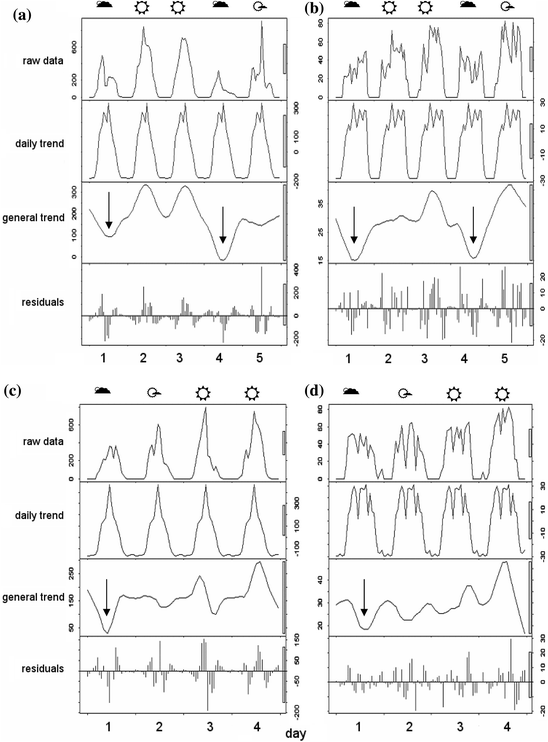 The sinusoidal swimming of fish, previously interpreted as foraging behaviour, was studied with respect to season, density of large zooplankton, fish length, time of the day, weather condition and solar radiation in Římov Reservoir, Czech Republic, using a bottom-mounted, split-beam transducer (7°, nominal angle; frequency 120 kHz). The proportion of sinusoidally swimming fish increased from April to August while this behaviour was absent in October. The occurrence of sinusoidal swimming showed an apparent pattern throughout the day; it increased sharply around sunrise, was highest within 5–6 h around solar noon, and sharply decreased around sunset. Significantly less frequent occurrence of sinusoidal swimming was recorded during cloudy days compared to sunny days. The vast majority of records came from fish of standard length ranging from 100 to 400 mm, which represents the typical size range of common bream Abramis brama and roach Rutilus rutilus of age >1+, the main zooplanktivores in the reservoir. The presence of these larger fish in the open water of the reservoir, as well as the presence of sinusoidal swimming, apparently correlates with the presence of large zooplankton (Daphnia, Leptodora and Cyclops vicinus) in the epilimnion. The increase of sinusoidal swimming between April, June and finally August resulted in an increase of zooplankton component in fish guts. It appears that high values of solar radiation, and stable calm weather during high pressure periods, result in optimal optical conditions for sinusoidal swimming, making this foraging behaviour more efficient and widely used in fishes exploiting the zooplankton production in the reservoir.
The sinusoidal swimming of fish, previously interpreted as foraging behaviour, was studied with respect to season, density of large zooplankton, fish length, time of the day, weather condition and solar radiation in Římov Reservoir, Czech Republic, using a bottom-mounted, split-beam transducer (7°, nominal angle; frequency 120 kHz). The proportion of sinusoidally swimming fish increased from April to August while this behaviour was absent in October. The occurrence of sinusoidal swimming showed an apparent pattern throughout the day; it increased sharply around sunrise, was highest within 5–6 h around solar noon, and sharply decreased around sunset. Significantly less frequent occurrence of sinusoidal swimming was recorded during cloudy days compared to sunny days. The vast majority of records came from fish of standard length ranging from 100 to 400 mm, which represents the typical size range of common bream Abramis brama and roach Rutilus rutilus of age >1+, the main zooplanktivores in the reservoir. The presence of these larger fish in the open water of the reservoir, as well as the presence of sinusoidal swimming, apparently correlates with the presence of large zooplankton (Daphnia, Leptodora and Cyclops vicinus) in the epilimnion. The increase of sinusoidal swimming between April, June and finally August resulted in an increase of zooplankton component in fish guts. It appears that high values of solar radiation, and stable calm weather during high pressure periods, result in optimal optical conditions for sinusoidal swimming, making this foraging behaviour more efficient and widely used in fishes exploiting the zooplankton production in the reservoir.
Keywords: Abramis brama; common bream; Cyclops vicinus; Daphnia; echosounder; Leptodora; roach; Rutilus rutilus; Římov Reservoir; Sonar5
